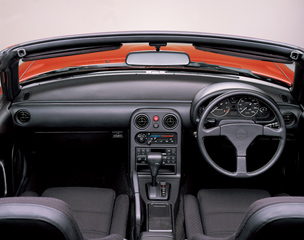MX-5(1989~)
Chapter1:Chasing the dream
Lightweight sports cars first appeared in the years following the Second World War, but it wasn’t until the 1960s that small, affordable and fun roadsters reached the height of their popularity. By fitting engines from standard sedans into compact and light vehicle bodies, automakers could provide exciting performance and agile handling that was also affordable. The lightweight sports car allowed average Europeans to enjoy exhilarating driving on a daily basis.
The 1970s saw the introduction of much stricter safety and emissions regulations in the US, the world’s largest automobile market. Since most of the lightweight sports cars were open top, they lacked the structural integrity provided by a roof. To meet the regulations, manufacturers instead added large shock absorbing bumpers or extra steel to increase body rigidity, which made the cars much heavier. In order to meet the new emissions regulations, many companies resorted to reducing the engine output. This was a tough period for the lightweight sports car, and as people’s expectations began to diminish, the roadsters disappeared from the market one after another.
In the early 1980s, with the lightweight sports car segment all but extinct, Mazda’s engineers conceived a dream for a modern compact two-seater. One engineer, who would go on to lead the development of the first generation Mazda Miata MX-5, was convinced that Mazda needed a unique product to help it stand out from the other Japanese brands, and passionately appealed to management to build a lightweight roadster.

Eventually, despite significant resistance from some of Mazda’s senior executives, the visionary engineer’s passion convinced the planning department in the R&D Division to take the first step.
Three alternative drive systems
Many different ideas were submitted in the planning phase. Layout proposals included front-wheel drive (FWD), rear-wheel drive (RWD) and even a mid-engine setup. The development team pored over early design sketches, and every aspect was discussed at great length, even as to whether it would be a convertible or a coupe.
Most small sports cars in the 1960s had an engine at the front with rear-wheel drive. By the 1970s, many mass produced vehicles had been switched to front-wheel drive (FWD). Although it went against the traditional concept of a sports car, this layout was much easier to build and provided greater flexibility in terms of engine and drivetrain combinations. The mid-engine layout, in which the engine is positioned near the center of the car and power is transmitted through the rear, shares the same advantages because the FWD engine and drivetrain can easily be carried over.
In order to minimize development and production costs, the best approach would have been to replace the body of a compact FWD car with a new sports car body, or perhaps reposition the engine and drivetrain for a mid-engine layout. Both options would allow the retail price to be kept low, and so provide the best chance for Mazda to bring back the lightweight sports car.
However, the agile handling and a linear driving feel that had made the original lightweight sports cars famous would be almost impossible to achieve without a RWD layout. For Mazda, this meant an entirely new powertrain would have to be developed, which would require a sizeable investment. In the end, despite the added cost, the engineers agreed that they had no choice but to pursue the ideals of a lightweight sports car.
Once the combination of RWD layout and an open-top body had been agreed on, the engineers coined the development concept, “Jinba Ittai” (which means “rider and horse as one”) to express the type of fun-to-drive roadster they intended to build. “Jinba Ittai” continues to symbolize each new generation of MX-5 and ensures that it will always remain true to Mazda’s original dream of a lightweight sports car.

